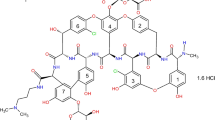Abstract
Purpose. The formation of succinimide intermediates at Asp-Gly sites and their hydrolysis products, e.g., isoAsp isomers, represents a common source of microheterogeneity in therapeutic proteins. Here we report on the stabilization effect of a zinc chloride induced precipitation of recombinant hirudin HV1 (rHir), an anticoagulant protein.
Methods. rHir was precipitated by zinc chloride at neutral pH to form a Zn-rHir suspension. An Arrhenius-type study (at 50, 40, 30, and 25°C) and a 4°C stability study were performed. Monitoring of rHir, rHir succinimides at Asp33-Gly34 (Q5) and Asp53-Gly54 (Q4), and further side products was by capillary electrophoresis (CE).
Results. The activation energies of rHir degradation in both aqueous rHir solution and Zn-rHir suspension were similar, i.e. 104.5 and 110.3 kJ/mol, respectively. Zn-rHir suspension demonstrated improved shelf-life stability (t90%, 95% confidence limit) versus rHir solution, i.e., 23 versus 3 days at 25°C and 292 versus 147 days at 4°C, respectively. In rHir solution, Q4 (Asp53-Gly54 succinimide) levels were slightly above Q5 (Asp33-Gly34 succinimide) levels. In Zn-rHir suspension, however, Q4 succinimide levels dropped markedly whereas Q5 levels were not affected. Correspondingly, in Zn-rHir isoAsp53-rHir levels were reduced but not isoAsp33-rHir levels.
Conclusions. In Zn-rHir suspensions, interactions of zinc and rHir show site-specific inhibition of succinimide formation only at Asp53-Gly54 (Q4), located in the highly flexible C-terminal tail of rHir. In contrast, succinimide formation at Asp33-Gly34 (Q5), located in a less flexible loop domain is not affected, reflecting steric hindrance.
Similar content being viewed by others
REFERENCES
F. Markwardt. Untersuchungen über Hirudin. Naturwissen. 42:537–538 (1955).
W. E. Märki, H. Grossenbacher, M. G. Grütter, M. H. Liersch, B. Meyhack, and J. Heim. Recombinant hirudin: genetic engineering and structure analysis. Semin. Thromb. Hemostasis 17:88–93 (1991).
P. Zoldhelyi, M. W. I. Webster, V. Fuster, D. E. Grill, D. Gaspar, S. J. Edwards, C. F. Cabot, and J. H. Chesebro. Recombinant hirudin in patients with chronic, stable coronary artery disease. Circulation 88:2015–2022 (1993).
T. Arvinte. Pharmaceutical compositions containing hirudin. Europ. Pat. 0624375A2 (1994).
H. Grossenbacher, W. Märki, M. Coulot, D. Müller, and W. J. Richter. Characterization of succinimide-type dehydration products of recombinant hirudin variant 1 by electrospray tandem mass spectrometry. Rapid communications in mass spectrometry 7:1082–1085 (1993).
T. Geiger and St. Clarke. Deamidation, isomerization, and racemization at asparaginyl and aspartyl residues in peptides. J. Biol. Chem. 262:785–794 (1987).
St. J. Wearne and T. E. Creighton. Effect of protein conformation on rate of deamidation: Ribonuclease A. Proteins 5:8–12 (1989).
S. Capasso, L. Mazzarella, F. Sica, A. Zagari, and S. Salvadori. Spontaneous cyclization of the aspartic acid side chain to the succinimide derivative. J. Chem. Soc. Chem. Commun. 919–921 (1992).
M. Xie, D. V. Velde, M. Morton, R. T. Borchardt, and R. L. Schowen. pH-induced change in the rate-determining step for the hydrolysis of the Asp/Asn-derived cyclic-imide intermediate in protein degradation. J. Am. Chem. Soc. 118:8955–8956 (1996).
P. Schindler, D. Müller, W. Märki, H. Grossenbacher, and W. J. Richter. Characterization of a β-Asp33 isoform of recombinant hirudin sequence variant 1 by low-energy collision-induced dissociation. J. Mass Spectrom. 24: 967–974 (1996).
A. Tuong, M. Maftouh, C. Ponthus, O. Whitechurch, C. Roitsch, and C. Picard. Characterization of the deamidated forms of recombinant hirudin. Biochemistry 31:8291–8299 (1992).
K. Patel and R. T. Borchardt. Chemical pathways of peptide degradation. II. Kinetics of deamidation of an asparaginyl residue in a model hexapeptide. Pharm. Res. 7:703–711 (1990).
S. Yoshioka, K. Izutsu, Y. Aso, and Y. Takeda. Inactivation kinetics of enzyme pharmaceuticals in aqueous solution. Pharm. Res. 8:480–484 (1991).
K. C. Lee, Y. J. Lee, H. M. Song, C. J. Chun, and P. P. DeLuca. Degradation of synthetic salmon calcitonin in aqueous solution. Pharm. Res. 9:1521–1523 (1992).
K. Forrer, P. Girardot, M. Dettwiler, W. Märki, H. Grossenbacher, and E. Gassmann. Different modes of capillary electrophoresis for the analysis of recombinant hirudin. 9th International Symposium on Capillary Electrophoresis, Budapest, Hungary, 1994.
U. Gietz, R. Alder, P. Langguth, T. Arvinte, and H. P. Merkle. Chemical degradation kinetics and mechanisms of recombinant hirudin (HV1) in aqueous solution: Effect of pH. Pharm. Res. 15:1456–1462 (1998)
C. Dette and H. Wätzig. Separation of r-hirudin from similar substances by capillary electrophoresis. J. Chromatogr. A 700:89–94 (1995).
C. Oliyai and R. T. Borchardt. Chemical pathways of peptide degradation. IV. Pathways, kinetics and mechanism od degradation of an aspartyl residue in a model hexapeptide. Pharm. Res. 10:95–102 (1993).
Author information
Authors and Affiliations
Rights and permissions
About this article
Cite this article
Gietz, U., Arvinte, T., Alder, R. et al. Inhibition of Succinimide Formation in Aqueous Zn-rHirudin Suspensions1. Pharm Res 16, 1626–1632 (1999). https://doi.org/10.1023/A:1018925209080
Issue Date:
DOI: https://doi.org/10.1023/A:1018925209080




